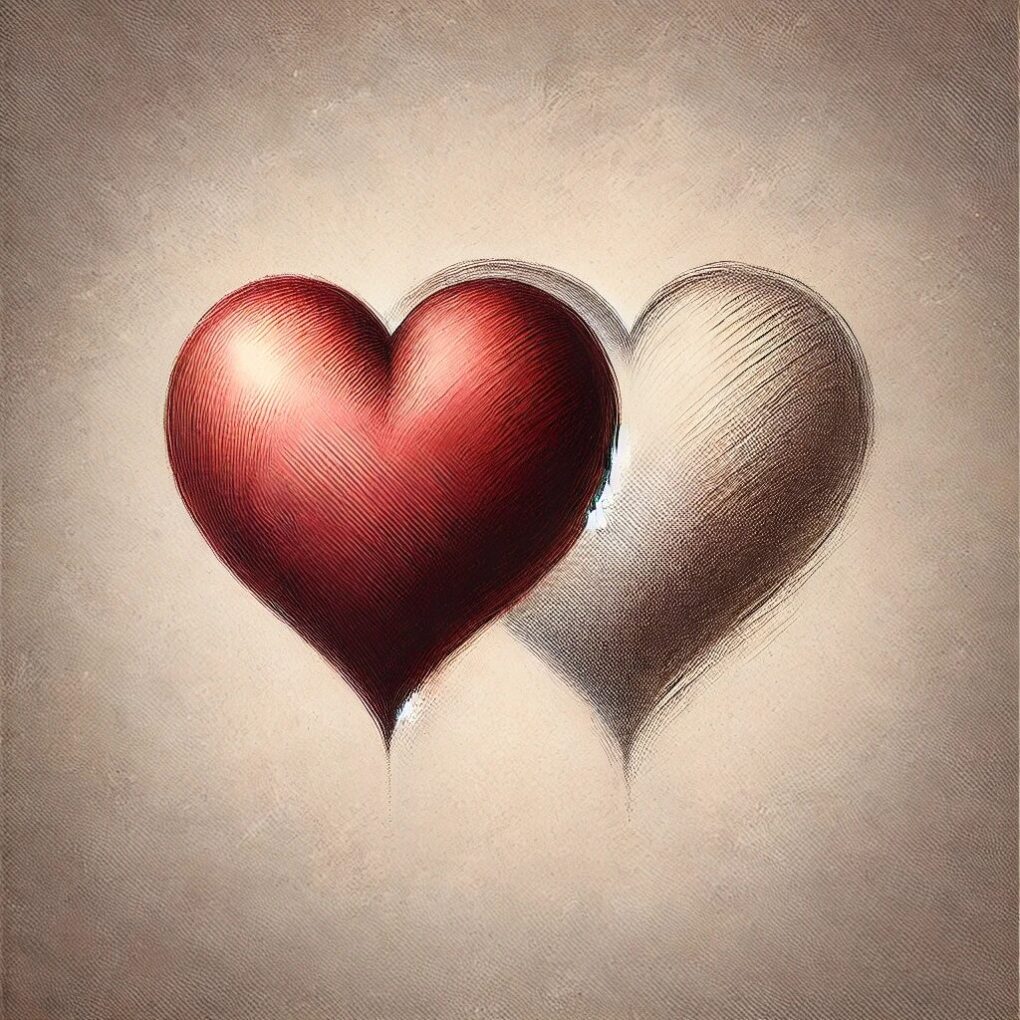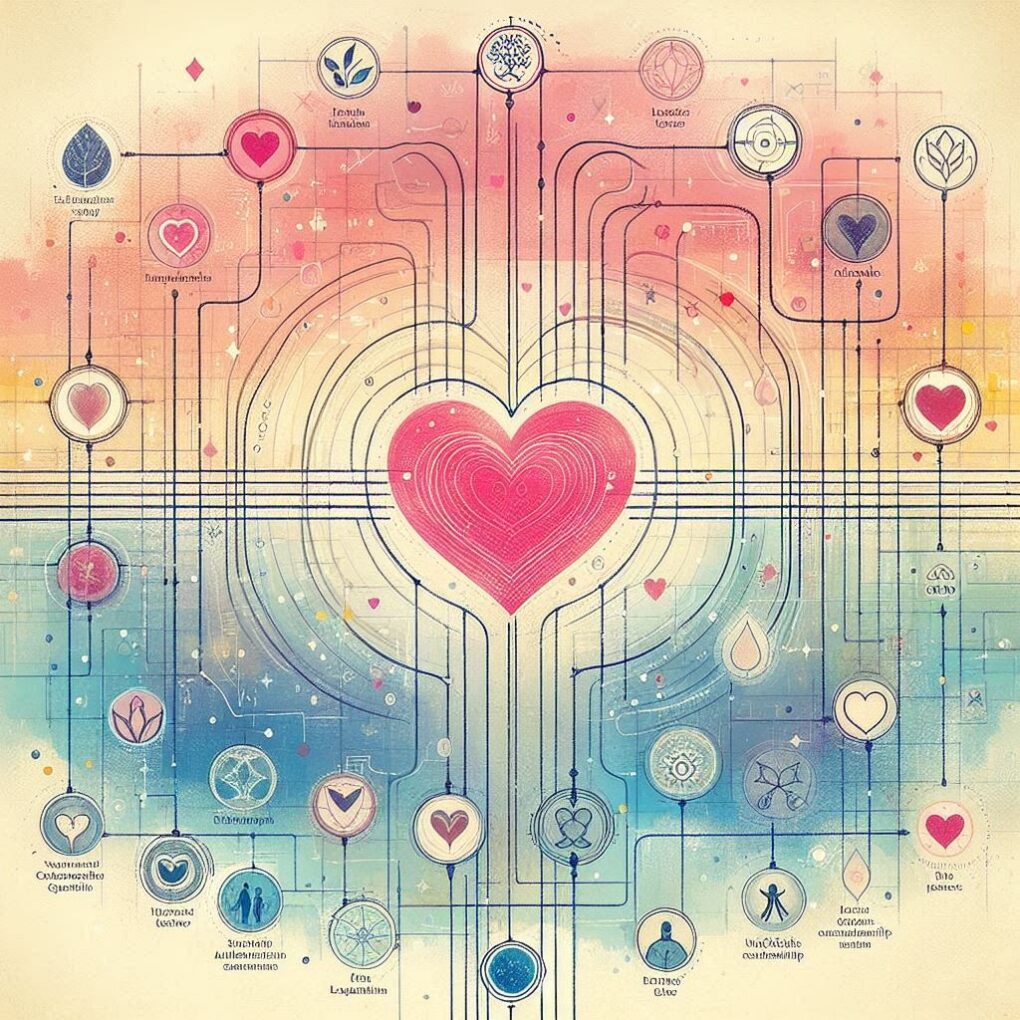- What Shapes Our Love and Relationship Patterns?
- Love Maps: Why We Love the Way We Do
- Psychological Traits: Personality Types That Spark Feelings
- Why Do We Love the Way We Do? Love Styles and Languages
- Our Experiences: How Our Upbringing, Culture, and Past Relationships Affect Attraction
- How Cultural and Societal Conditioning Affect Our Love Patterns
- Coming Soon: More About Why We Love the Way We Do

Have you ever wondered, “Why do we love the way we do?” In your search for love, have you felt like you’re winging it?
It’s like when you meet someone new and feel sparks. But a few months later, when you find out they’re a mismatch, you realize you’re repeating the same relationship patterns. Have you ever wondered how you can improve your chances for success?
You might be following a love map shaped by:
- Your biology
- Upbringing
- Past experiences
- Cultural messages
Once you know how to read that map, you can start rewriting your love story with a happier ending. To help you revise it, this is an overview of a series about where our beliefs about love come from, how they have affected our love lives, and how we can change the results.
Through seeing the “bigger picture” of the factors involved and how they intersect, we can develop a deeper understanding of ourselves and who we truly are.
What Shapes Our Love and Relationship Patterns?
When we’re born, no one gives us a user manual. Beyond basic communication skills, our parents and teachers generally didn’t teach us about relationship dynamics. Early on, we learned from our observations and experiences. Our beliefs and even our biology also shape everything from who attracts us to why our relationships succeed or fail.

That’s why our search for romantic love often feels like a trial-and-error process.
For instance, I’ve often felt that being in a fulfilling relationship was vital to my happiness. That belief stemmed from low self-esteem, others’ expectations, and societal pressure — mostly that women should be married by a certain age.
Our relationship patterns also influence how we connect with partners. Relationship patterns develop based on our attachment styles, past experiences, and belief systems. Sometimes they lead us to healthy connections, but at other times, they trap us in cycles that don’t serve us. Understanding their origin can help you break free and build genuine, meaningful relationships.
✅ Example: If you often fall for emotionally unavailable partners, exploring why and what to change can help you form healthier bonds.
Discover Your Dating Authenticity Score
You laugh at jokes that aren’t funny. Nod along to plans you’d rather skip. Or hold back a reply in an attempt to keep them interested.
But is that really you — or just an act?
Take this free quiz to see if you’re showing up as your true self in dating — or if you’re hiding behind a mask (without even realizing it).
So, the “baggage” we carry affects how we see love and attraction and our dating and relationship behavior. Let’s explore those influences.
Love Maps: Why We Love the Way We Do
A “love map” is our inner guide to who attracts us and how we approach relationships, shaped by our genetics, upbringing, personalities, experiences, and beliefs.

It’s like your personal playlist on shuffle. Some songs — like childhood memories of your parents’ relationship — have been on repeat for years. Others, like that rom-com you watched a hundred times, stay stuck in your head and affect your expectations of love.
From the moment we’re born, we form a concept of romantic love, which changes as we grow. In Western cultures, beyond our upbringing, stories are major influences on our love maps, which often follow the formula of a couple falling in love, marrying, and living “happily ever after.”
But real-life love is rarely that simple (or perfect). Like every one of us, each of our maps is unique. They don’t just encompass physical attraction or lovemaking preferences, but how we handle conflict and intimacy and view monogamy.
Genetics and Evolutionary Biology: The Search for Fertility, Strength, and Compatibility
Ever wonder why so many Hollywood heartthrobs are tall with chiseled jawlines? Science says symmetry and height signal strength, and our instincts take note — whether or not we realize it.
Our earliest attraction patterns come from our DNA. Evolution has wired humans to seek traits that signal fertility, strength, or security — qualities tied to survival and successful reproduction. These biological drives affect first impressions. Let’s explore the scientific evidence behind how each gender is wired to be drawn to certain physical traits.
Physical Attractiveness: How We Assess First Impressions Based on Looks
When we find someone attractive, we tend to coast on that initial impression, even if the person later reveals red flags (“The Science of Love” by Glenn Wilson and Chris McLaughlin).
Heterosexual men: They’re generally attracted to younger women who are shorter and have a low waist-to-hip ratio (WHR). They see these traits as signs of health and fertility; youth also triggers their nurturing instincts.

In women, WHR drops around the onset of puberty, then rises with age and childbirth. It can signal reproductive potential, which peaks in the twenties.
A 2024 Nature Scientific Reports study found men prefer curviness to a specific WHR. It also showed cultural variations in preferences. Iranian and Norwegian men favored higher WHRs in women compared to Polish and Russian men.
In non-Western countries, ultra-thinness is considered unattractive and undesirable; many heterosexual men still prefer more voluptuous female body types (“The Science of Love”).
Gay men: Generally, research suggests tall gay men prefer shorter partners, and vice versa. Moreover, men also linked height to sexual roles: men who desired a more dominant and active role liked shorter partners, while men who preferred a more passive role preferred taller partners.
Heterosexual women: Women tend to prefer partners who seem like good providers. They often gauge a potential mate’s earning power, education, age, or height.
Positive Outlooks reports that “Women prefer taller men because they are perceived to be stronger and better skilled in warding off physical threats to their family.” A 2015 study upholds this traditional view; over 300 female respondents with an average age of 22 said they preferred younger, taller men in their racial group from a higher social class.

Both sexes: A recent UC Davis study of 6,000 adult men and women using a matchmaking service showed that despite their responses, they both were slightly more attracted to younger partners, a trend consistent from ages 22 to 85.
Symmetry of features is also an unconscious factor in attractiveness.
And to some extent, “sexual imprints” influence our “types,” based on how our opposite-sex parents looked when we were children. They also apply to age preferences. For example, a girl whose father was middle-aged when she was born is more likely to be attracted to older men when she grows up.
Sexual orientation and age preferences: Studies suggest homosexuals’ age preferences generally mirror those of heterosexuals. Gay men tend to be attracted to young men, while lesbians tend to be interested in women closer to their age.
This aligns with the modularity hypothesis of sexual orientation (e.g., Symons, 1979), which asserts that homosexuality and heterosexuality share similar sexual psychology and attraction patterns. Limited research on bisexuals’ age preferences suggests they’re also interested in young partners.
Stereotypes: Unconscious biases influence attraction, often tied to physical traits like:
- Height: Shorter women and men can be seen as less attractive and successful.
- Glasses: Women who wear glasses are often perceived as smarter or more serious.
- Baldness: “Skinheads” seem more threatening.
- Hair color: Men can see blondes as less intelligent than brunettes and red-heads as hot-tempered. One study found that people considered red-haired women unattractive yet competent and professional. Red-haired men were viewed as not only unattractive, but less successful and more effeminate compared to dark or blonde haired men. (“The Science of Love”)
Psychological Traits: Personality Types That Spark Feelings
Even if someone looks appealing, you’re not always attracted to them, which means more elements are needed to ignite a spark. Beyond appearances, prejudice or unappealing traits like selfishness can repel us.
We often connect with people like ourselves or who share similar love or attachment styles.
A study suggests that though we might know which qualities we seek (such as traits like kindness or intelligence), they don’t always dictate our choices. Notably, some attributes like religious faith were stronger attraction predictors than physical appearance.
How Personality and Temperament Color Our Love Styles
Some of us are highly sensitive, introverts, or extroverts, which subtly affect what draws us and how we express love.
Personality frameworks like the Myers-Briggs Type Indicator (MBTI), the Enneagram, and Highly Sensitive Person (HSP) theory offer insights into these nuances. These unconscious traits and attitudes can also show why we love the way we do.
- The MBTI: This personality self test divides people into 16 types based on four preference scales: Extraversion vs. Introversion, Sensing vs. Intuition, Thinking vs. Feeling, and Judging vs. Perceiving. Inspired by Carl Jung’s theory, it aims to provide insights into personality, communication, and decision-making. Though popular, its accuracy has been debated.
- The Enneagram: It maps nine types, each with unique motivations and emotional and behavioral patterns. It’s based on the idea that an innate personality structure shapes how we view ourselves and our world. Points on a circular diagram represent each type.
- HSP Theory: In her 1996 book, “The Highly Sensitive Person,” Dr. Elaine Aron described Highly Sensitive People (HSPs) with heightened sensitivity, deeper mental processing, and higher empathy. Her research suggests about 15-20 percent of people are HSPs. As many as 70 percent are introverts, while 30 percent are extroverts. All empaths are HSPs, but not all HSPs are empaths.
Example: If you’re an HSP, you might sense subtle emotional shifts your partner doesn’t show outwardly that others wouldn’t notice.
HSPs can be labeled “shy,” “introverted,” or “fearful.” What looks like shyness is often overstimulation; they’re slow to “warm up” or adjust to their surroundings. Though people with autism or Asperger’s can be HSPs, HSPs aren’t on the autism spectrum of disorders.
Why Do We Love the Way We Do? Love Styles and Languages
In 1973, psychologist John Lee introduced another layer into our understanding of how our personalities affect our romantic relationships: love styles. Based on his color wheel theory, love styles reveal the emotional tone and motivations behind how we show love.
Lee discovered six primary love styles:
- Eros (Romantic, Passionate Love): Intense, physical attraction and deep emotional connection.
- Ludus (Playful Love): Flirtatious, game-like love that often avoids deep commitment.
- Storge (Companionate Love): Love that grows slowly from friendship and shared experiences.
- Pragma (Practical Love): Love based on compatibility and shared goals.
- Mania (Obsessive Love): Love marked by emotional highs and lows and jealousy.
- Agape (Selfless Love): Unconditional, altruistic love focused on giving without expecting in return.
Clyde and Susan Hendrick later expanded on Lee’s work with their Love Attitudes Scale (LAS), deepening our understanding of how these styles play out in relationships.
We also speak in our own “love languages,” a concept Dr. Gary Chapman presented in his 1992 book “The Five Love Languages.” He identified five ways people express and receive love:
- Words of Affirmation
- Acts of Service
- Receiving Gifts
- Quality Time
- Physical Touch
He noted that mismatched love languages can cause misunderstandings in relationships. Though widely adopted in relationship psychology, the theory has been criticized for its simplicity and lack of scientific rigor. The original book was also written from a heteronormative, conservative Christian perspective that focused on white, heterosexual, monogamous couples and traditional gender roles.
Our Experiences: How Our Upbringing, Culture, and Past Relationships Affect Attraction
Early Parenting and Relationships
The way we love didn’t form in isolation — it was woven from our earliest bonds, cultural surroundings, and the echoes of past relationships.

Maria, at one of Michelle’s early birthday parties
Parents, caregivers, and family dynamics influenced our first love map. If we felt safe and reliable while we were raised, we might approach relationships with trust. But if parental love felt inconsistent or conditional, we might carry insecurities into adulthood.
Four types define our relationship patterns:
- Secure attachment → Forms stable, trusting relationships and repeats healthy patterns.
- Anxious attachment → Often seeks validation, and can attract avoidant partners and repeat cycles of emotional highs and lows.
- Avoidant attachment → Tends to pull away when intimacy deepens, reinforcing a pattern of short-term or distant relationships.
- Disorganized attachment → A mix of anxious and avoidant tendencies; struggles with conflicting desires for closeness and independence.
Understanding your attachment style can clarify relationship patterns and recognizing these dynamics can help you heal and foster healthier connections.
Past Romantic Experiences
Whether you’ve experienced heartbreak, betrayal, or emotional neglect, those experiences mold how you trust, attach, and communicate. If we tend to repeat certain behaviors in our romantic relationships, they’re part of a pattern.
Example: Attracting emotionally unavailable people consistently might highlight an anxious attachment style.
How Cultural and Societal Conditioning Affect Our Love Patterns
Media, social norms, and romantic tropes influence our expectations of love.
From fairy tales to rom-coms, the media can reinforce the idea that love should be magical.
Example: the idea of finding “the one” or a “soulmate” can distort our view of reality, causing us to cling to unhealthy relationships.
When we don’t understand how and why we love the way we do, we can feel lost — disconnected from our true selves. This can lead us to attract relationships that mirror wounds we haven’t resolved.
For example, if you disregard your values to appease a partner, you can blur your sense of identity, showing a lack of conviction, leading your partner to pull away.
Peeling back these layers helps us reach our core or true selves — the ones with a clear view through the clouds.
💭 Reflection Questions
Think for a few moments. Ask yourself:
- Which patterns have I noticed in my dating history?
- Where did my beliefs about love come from?
- What’s one thing I’d like to change about how I approach relationships?
As you reflect on your love map, consider the patterns you’ve repeated. Understanding these influences can clarify why you follow certain patterns — and help you change them.
Coming Soon: More About Why We Love the Way We Do
Later, we’ll explore how these influences have contributed to our love maps — and how they block our abilities to attract true love.
Up next, we’ll break down attachment styles, one of the biggest predictors of how we connect, pursue, and choose our partners (and sometimes sabotage) relationships. If you’ve ever wondered why you keep choosing the wrong partners, we’ll examine the clues to answer that question.
Why do we love the way we do? Which beliefs about love have influenced you?
- Why Do We Love the Way We Do? - March 14, 2025
- 5 Reasons I Believe in Mindful Dating and Why You Should Embrace Vulnerability, Too - January 19, 2025
- Single and Lonely No More: 7 Steps to Happiness and Fulfillment - November 1, 2024